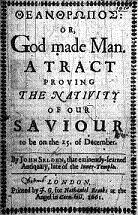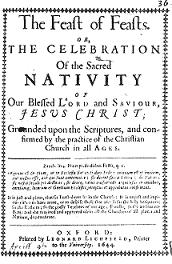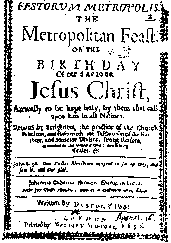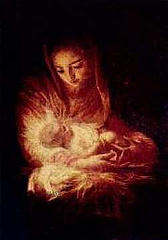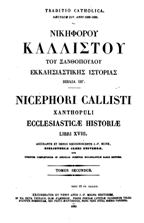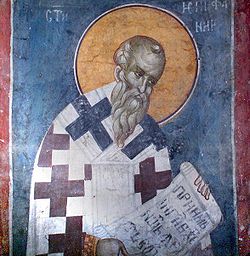Revisiting the FathersAn Examination of the Christmas Date in Several Early Patristic Writers
Kurt M Simmons, JD
The article that is redefining the debate about the origin of the Christmas date |
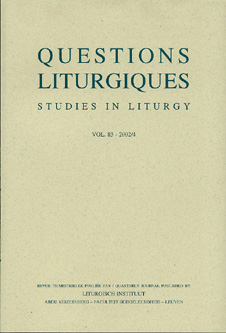 |
Editor's note: This article appeared in 98 Questions Liturgiques (2017) 143-180. The article documents occurrence of the Christmas date to sometime between the mid- first to mid- second centuries. Specifically, it demonstrates from heretofore lost or unrecognized excerpts of Julius Africanus (AD 160-240) and a work attributed to Evodius (died circa AD 64-68) that the Christmas date was an integral part of the Protoevangelium of James before it settled into its present form sometime in the latter half of the second century. The article then shows that the above conclusions are supported by a published article by Yale PhD candidate, Thomas C. Schmidt, which shows that Hippolytus (AD 170-236), a younger contemporary of Africanus, also almost certainly subscribed to the December 25th birth of Christ. The article concludes that the Christmas date therefore cannot be accounted for by other leading theories, and instead appears to stem from an early tradition (legend or report) whence it was received in good faith by the fathers of following ages.
.jpg) |
| Author |
Note Regarding T91 and Cyril Alexandrinus
(Post-publication update)
It
has long been proposed that Julius Africanus held to the
December 25th birth of Christ. This paper offers
direct evidence that this is in fact the case. Central to that
argument is the conclusion that Africanus is the ultimate author
of the Excerpta Latina Barbari, and probably the original
source of the March 25th - December 25th -
March 25th triad for the dates of the annunciation,
nativity, and passion that became prominent among early
Christian computists and chronographers, and is embedded in
ecclesiastical calendars until this day.
Evidence supporting these conclusions exists in eight points of
correspondence between Africanus and the Excerpta Latina
Barbari. Perhaps most striking of these is the correlation
between T91 and the Excerpta. T91 states that “Cyril and
Africanus together with some others report that Christ was seven
days old when the magi arrived.”[1] The
Excerpta place the nativity at 8 kalends of January (Dec. 25th)
and states that the Magi arrived January 1st. Seven
days from Dec. 25th is January 1st.
Therefore, T91 and the Excerpta agree.
But
who is the “Cyril” mentioned in T91, Cyril Alexandrinus or Cyril
of Jerusalem? This question, unanswered in the main article, may
now be settled: Cyril Alexandrinus.
Dionysius Bar Salibi, Bishop of Amida (died AD 1171), states in
his commentary on the Gospels:
|
Saint Cyril and John say: When Christ was a little infant and
wrapped in swaddling bands, the Magi found him. For they
say the star appeared to the Magi before the time of the
nativity, so that in under eight days of his nativity,
as said Cyril, they came to him.[2] |
Reference to a “Cyril” and “under eight days” for the arrival of
the magi corresponds closely to T91 and almost certainly refer
to the same individual. According to Witold Witakowski, Bar
Salibi refers to Cyril Alexandrinus and his commentary on
Matthew which is now lost.[3] Although
Cyril’s commentary on Matthew is lost, happily we do have his
homilies on Luke, and these indicate Cyril placed the arrival of
the magi soon after Jesus’ birth, while the babe was in the
manger at Bethlehem:
For contemporaneously with the birth of Christ the power of the devil was spoiled. For in Damascus he had been the object of religious service, and had had there very many worshippers; but when the holy Virgin brought forth, the power of his tyranny was broken; for the heathen were won unto the knowledge of the truth; and their firstfruits and leaders were the Magi, who came from the East to Jerusalem; whose teacher was the heaven, and their schoolmaster a star. Look not therefore upon Him Who was laid in the manger as a babe merely, but in our poverty see Him Who as God is rich, and in the measure of our humanity Him Who excels the inhabitants of heaven, and Who therefore is glorified even by the holy angels.
Cyril
thus weaves the arrival of the magi from Matthew into the birth
narrative of Luke, and places their arrival while the
Christ-child was still in the manger. This is consistent with
Bar Salibi’s statement that Cyril placed the arrival of the magi
less than eight days from the nativity. Review of Chrysostom’s
homilies on Matthew show that Chrysostom also placed the magi’s
arrival while the babe was wrapped in swaddling clothes, lying
in a manger.[4] Witatowski
therefore appears to be correct that Bar Salibi refers to Cyril
Alexandrinus and John Chrysostom. And since Bar Salibi and T91
(also of Syrian origin) doubtless refer to the same individual,
we may conclude that Cyril Alexandrinus is the subject of both.
Moreover, since Bar Salibi tends to confirm the truth of T91
regarding Cyril, its testimony regarding Africanus doubtless is
equally dependable.
Kurt
Simmons
May 2021
[1] Julius
Africanus, Chronographiae, The Extant Fragments,
ed. Martin Wallraff, transl. Wiliam Adler (New York: De
Gruyter, 2007), 275.
[2] “Sanctus
Cyrillus et Joannes dicunt: Cum esset Christus
infantulus et pannis circumdatus, invenerunt eum Magi.
Dicunt enim ante tempus nativitatis eius apparuisse
Magis stellam, ita ut infra octo dies nativitatis eius,
ut dixit Cyrillus, ad eum convenerunt.” Dionysii Bar
Salibi, “Commentari in Evangalia” in
Scriptores Syri, Series Secunda (Parisiis,
e Typographeo reipublicae,
1906), p. 68. Translated from Syriac to Latin by
I. Sedláek;
translated from Latin by the author.
[3] Witold
Witakowski, “The Magi in Syria Tradition” in Malphono
w-Rabo d-Malphone: Studies in Honor of Sebastian P.
Brock, editor George A. Kiraz, Piscataway (Gorgias
Press, 2008), p. 829.
______________________________
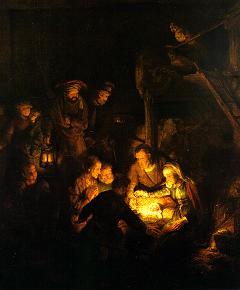
Adoration of the Shepherds
All rights reserved.
 John Seleden’s
John Seleden’s